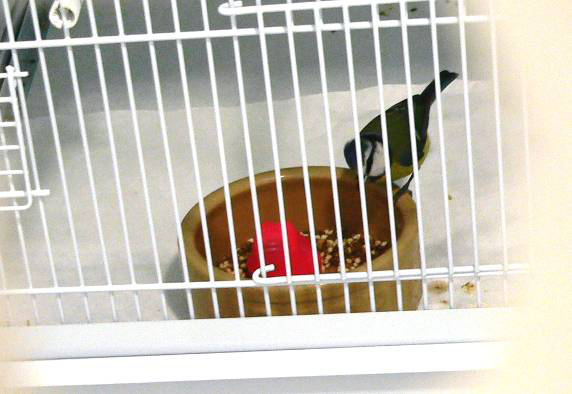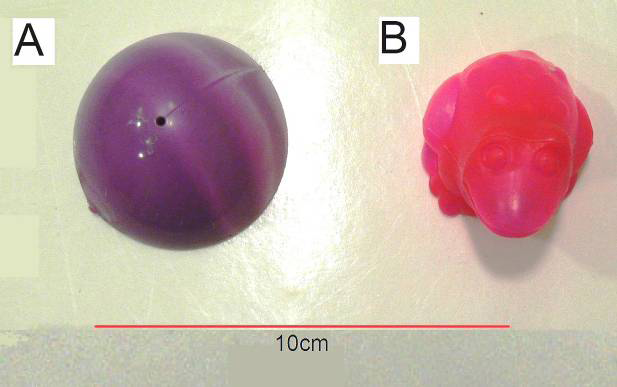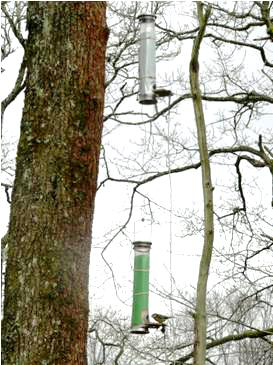or, in this case, a neophobic Blue Tit in a cage is also a neophobic Blue Tit in the wild. Now this, might not sound like anything of particular ground-breaking significance, but in the context of animal personality research, it is a fairly big thing.
Whilst working on Scarlet Macaws in Costa Rica, I had the pleasure of having Katherine Herbourn assist with some of the field work we were doing. Katherine went on to continue with her academic career and has just completed a fascinating PhD entitled “Variation in response to environmental cues when foraging” in which she examined Blue Tits Cyanistes caeruleus and Greenfinches Carduelis chloris, amongst other species, in an effort to try understand the factors that affect foraging behaviour.
Blue Tit (Cyanistes caeruleus) with a frog in its food. (c) Katherine Herbourn
Katherine started off by looking at how captive Blue Tits responded to having a bright red frog placed in their food bowl. Evidently, some individuals were a whole lot more wary of the unknown intruder than others. This gets me wondering how I would react if my Thai green curry had a red frog floating in it. I think I would just eat around it. As long as the red frog had never been living. In which case, I have no idea how I would react.
Item B is a plastic red frog. I think item A is the top of a purple Klingon’s head. Photo (c) Katherine Herbourn
She also characterized the exploratory tendency of these Blue Tits. These sorts of tests have been done in many species and it has always been assumed (hoped), that what they found in the little white cages at the back of the zoology department had some wonderful relevance to what happened in the real world. So Katherine let all her new found friends out again (with appropriate jewellery, of course).
This Blue Tit was not scared when his feeder suddenly turned green. (c) Katherine Herbourn
As it turned out, the Blue Tits that were scared of the silly plastic toys in their food (let’s call them neophiles to sound fancy), were the same tits that got wary of the feeding station (which they had been feeding at previously) when it suddenly changed colour. And – surprise surprise – the Blue Tits that were more exploratory in their feeding habits, trying out newly available food sources in new locations (and at different times), were equally exploratory in the wild as they were back in the lab.
Now, none of this surprised me. Sweet, so they show the same personality traits in a cage as in the wild. But what did surprise me was that these two traits were independent. Evidently, the birds that were not afraid of the unknown at a trusted feeding station were not necessarily the same birds as those that were seeking out completely new feeding locations or opportunities.
I wonder, do we find a similar thing in people?
If I am very exploratory in my restaurant choice (or holiday venue), does this say anything about my reaction when something unknown “invades” my personal space or trusted environment?
What do you think?














That should be “wary of” not “weary of”. Two instances that I saw. “Weary of” is saying almost exactly the wrong thing.
@David Craig: Fixed!
Dale, cool post. And great question. I too like to be a bit adventurous in my eating and travel plans but I don’t think I would be a big fan of the unknown in my personal space…
@ David, spelling corrected (thanks Corey). Sometimes my hands type faster than my tired brain. Anything thoughts on the question though?
@ Corey, I suspect lots of people that we choose to (virtually) hang out with may be open to exploring; with this tendency reflected in an exploration of electronic space. But might fiercely defend the norm at home. But off the top of my head, I cannot think of any examples of non-exploratory people who are open to the unexpected at home.
Maybe I can convince Katherine to pop by and share some of her insight in to the nature of garden birds with us…
hello Dale
Thanks for this!
I like the neophobia-exploration issue too. Researchers comparing these traits across groups of closely related species – parrots, tits, sparrows, darwins finches etc – find no general correlation between neophobia and exploration. Instead, those species that are neophobic tend to have either a naturally.. sort of “bland” diet (e.g. specialists v generalists) or be those whose food poses some kind of dietary risk (e.g insects (often noxious) versus leaves). So the human equivalent of frog in a bowl might be.. food selection from some kind of mystery buffet?
Exploratory species, on the other hand, have lifestyles where information gathering could be useful, e.g. those living in relatively complex and changeable versus constant habitats. Makes sense really. So assaying exploratory tendency in humans.. Hmm.. Perhaps who you gravitate toward at parties- new people or old friends?
But the fittest personality – best combination of such traits – will depend on the environment. Humans can probably just find their own little place to thrive.